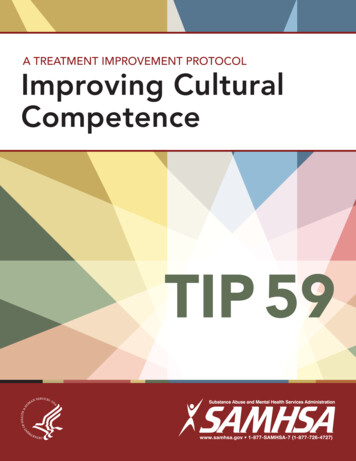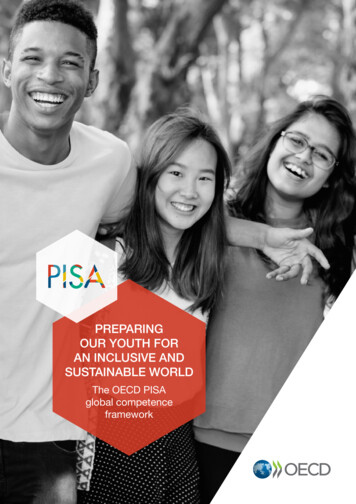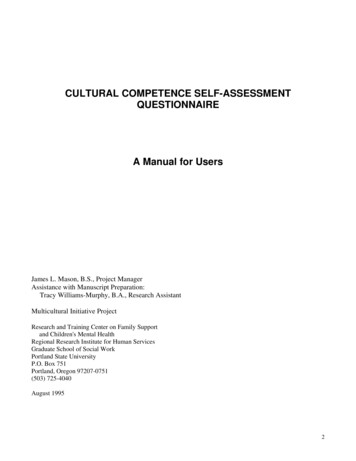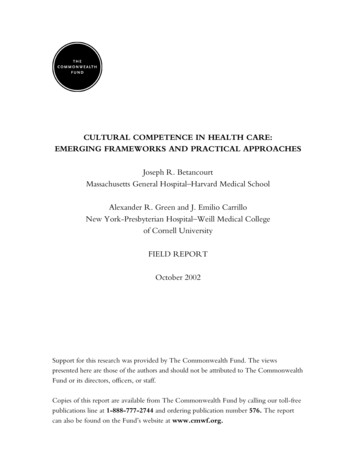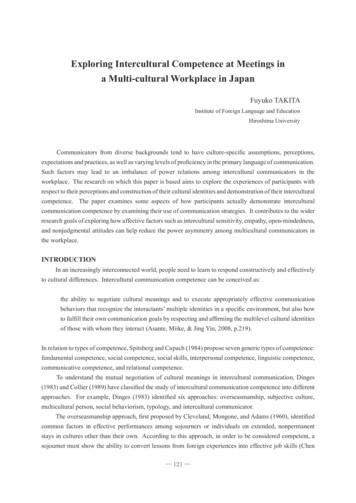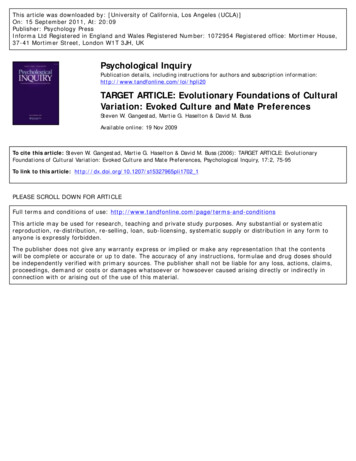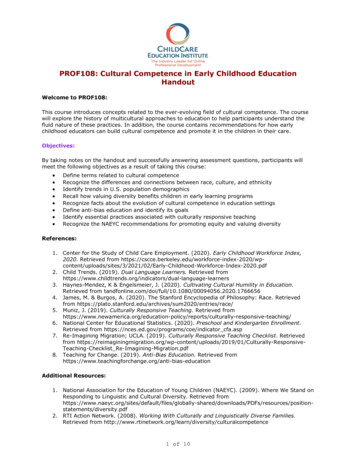
Transcription
PROF108: Cultural Competence in Early Childhood EducationHandoutWelcome to PROF108:This course introduces concepts related to the ever-evolving field of cultural competence. The coursewill explore the history of multicultural approaches to education to help participants understand thefluid nature of these practices. In addition, the course contains recommendations for how earlychildhood educators can build cultural competence and promote it in the children in their care.Objectives:By taking notes on the handout and successfully answering assessment questions, participants willmeet the following objectives as a result of taking this course: Define terms related to cultural competenceRecognize the differences and connections between race, culture, and ethnicityIdentify trends in U.S. population demographicsRecall how valuing diversity benefits children in early learning programsRecognize facts about the evolution of cultural competence in education settingsDefine anti-bias education and identify its goalsIdentify essential practices associated with culturally responsive teachingRecognize the NAEYC recommendations for promoting equity and valuing diversityReferences:1. Center for the Study of Child Care Employment. (2020). Early Childhood Workforce Index,2020. Retrieved from rkforce-Index-2020.pdf2. Child Trends. (2019). Dual Language Learners. Retrieved nguage-learners3. Haynes-Mendez, K & Engelsmeier, J. (2020). Cultivating Cultural Humility in Education.Retrieved from 66564. James, M. & Burgos, A. (2020). The Stanford Encyclopedia of Philosophy: Race. Retrievedfrom s/race/5. Muniz, J. (2019). Culturally Responsive Teaching. Retrieved ports/culturally-responsive-teaching/6. National Center for Educational Statistics. (2020). Preschool and Kindergarten Enrollment.Retrieved from https://nces.ed.gov/programs/coe/indicator cfa.asp7. Re-Imagining Migration; UCLA. (2019). Culturally Responsive Teaching Checklist. Retrievedfrom s/2019/01/Culturally-ResponsiveTeaching-Checklist Re-Imagining-Migration.pdf8. Teaching for Change. (2019). Anti-Bias Education. Retrieved ucationAdditional Resources:1. National Association for the Education of Young Children (NAEYC). (2009). Where We Stand onResponding to Linguistic and Cultural Diversity. Retrieved ments/diversity.pdf2. RTI Action Network. (2008). Working With Culturally and Linguistically Diverse Families.Retrieved from competence1 of 10
3. Sparks and Edwards. (2010). Anti-Bias Education for Young Children and Ourselves. NAEYC:Washington, D.C.4. Wardle, Francis, (2007). Diversity in Early Childhood Programs. Early Childhood News.5. Wilson, K. (1995). Multicultural Education. Retrieved eith.htmlCourse Notes:Use the space below to record important information from the course.Why This Topic Is Essential for Early Childhood EducatorsIn 2019, the National Association for the Education of Young Children published the Advancing Equityin Early Childhood Education Position Statement, which states:An early childhood professional’s job is to help:It is also important to note that much of a child’s self-identity and self-esteem developwithin:As you explore resources, you may see words such as intercultural, which differs from multicultural inthe following way: Multicultural- Intercultural-Given these two scenarios, the goal should be to create communities. Cultural competence- Culturally responsive teaching-2 of 10
Cultural humility-During this course, we will use the termand acknowledge the need for continuous self-evaluation and growth.Anti-bias education:American Diversity: By the NumbersA Brief Look at U.S. Population DataThe most recent census shows greater diversity than the last census. In short, America is becoming:The number of children living in households that speak a language other than English rose from about20 million in 2004 to in 2016.Culture, Race, and EthnicityImportant FactsCulture:Race:Ethnicity:Race, culture, and ethnicity are related in certain ways, but it is dangerous to assume too much aboutsomeone based on their .3 of 10
Promoting DiversityValuing DiversityAccording to Wardle, this means that children in our programs must: Learn about their own backgrounds;Learn about the backgrounds of people who are different from them;See themselves, their families, and their communities represented throughout the center;Continually be exposed to activities, materials, and concrete experiences that destroystereotypes;Learn to enjoy, appreciate, and seek out differences;Learn that harassment and intolerance is never acceptable, andDiscover that there are usually a whole variety of ways to solve a problem, complete a task, oranswer a questionAccording to Wardle, while in programs using an anti-bias approach, children should: See themselves, their families, and their communities represented throughout the program.Experience activities, materials, and interactions that destroy stereotypes.Challenge assumptions and norms.Learn to enjoy, appreciate, and seek out differences.Learn that harassment and intolerance are never acceptable.Discover that there are a variety of ways to solve problems, complete tasks, and answerquestions.The Evolution of Multicultural Education ApproachesMulticultural education rose to prominence during the 1980s and ‘90s as education reformers andresearchers sought new ways to close the .One of its important goals is to help all students to acquire the:4 of 10
Challenges and Resistance to Multicultural Education Very broad goals. It encourages teachers to focus attention on differences, thereby reinforcing ratherthan reducing ethnic bias and racism. A “feel-good” curriculum activities and token or superficial displays of culturalstereotypes. An ambiguous or simplistic approach. Rethinking cultural norms.Anti-Bias EducationImportant FactAnti-bias education focuses on:The Vision of Anti-Bias EducationGoals of Anti-Bias EducationGoal 1 - Each child will demonstrate self-awareness, confidence, family pride, and positive socialidentities.Goal 2 - Each child will express comfort and joy with human diversity; accurate language for humandifferences; and deep, caring human connections.Goal 3 - Each child will increasingly recognize unfairness, have the language to describe unfairness,and understand that unfairness hurts.Goal 4 - Each child will demonstrate empowerment and the skills to act, with others or alone, againstprejudice and/or discriminatory actions.5 of 10
Cultural CompetenceImportant FactCultural competence as defined by the National Education Association:Cultural competence is having an awareness of one’s own cultural identity and views aboutdifference, and the ability to learn and build on the varying cultural and community norms ofstudents and their families. It is the ability to understand the intragroup differences that makeeach student unique, while celebrating the intergroup variations that make our country atapestry. This understanding informs and expands teaching practices in the culturallycompetent educator’s classroom.RTI Action Network Guidance on Cultural CompetenceResponse to Intervention (RTI) Action Network offers this more detailed guidance in its article“Working with Culturally and Linguistically Diverse Families”:Cultural competence is a term that describes what happens when special knowledge aboutindividuals and groups of people is incorporated into standards, policies, and practices. Theprocess of achieving cultural competence is one that leads not only to an appreciation offamilies and their unique backgrounds, but also to an increase in the quality and effectivenessof services, producing better outcomes.According to RTI, to ensure cultural competence, programs should:Have a set of values and principles that recognize diversity –Demonstrate behaviors, attitudes, policies, and structures that enable them to workeffectively cross-culturally and value diversity –Conduct self-assessment to ensure sensitivity to cultural characteristics –Be committed to manage the “dynamics of difference” –Learn about and incorporate cultural knowledge into their practices –6 of 10
Adapt to diversity and the cultural contexts of the communities they serve -Culturally Responsive TeachingCulturally responsive teachers gather as much information about each child’s culture as possible anduse that information to assist in their planning, family engagement, assessment processes,environment, and selection of materials used to support children’s learning.Culturally responsive teachers develop strategies to engage students in instruction:Cultural responsiveness also revolves around relationship-building and communication:Benefits of Culturally Responsive TeachingAccording to several research studies, students who participated in culturally responsive learningenvironments benefited from several positive outcomes. Higher levels of engagement with the material.A better comprehension of content when linked to prior knowledge.A deeper understanding of academic concepts when materials were linked to students’backgrounds.Higher attendance rates and interest in school.Stronger persistence with assignments.Development of positive racial and ethnic identity, which translated to higher self-esteem.Improvements to the social/emotional climate of the learning environment.7 of 10
Eight Competencies for Culturally Responsive TeachingCompetency 1: Reflect on One’s Cultural LensCompetency 2: Recognize and Redress Bias in the SystemCompetency 3: Draw on Students’ Culture to Shape Curriculum and InstructionCompetency 4: Bring Real-World Issues into the ClassroomCompetency 5: Model High Expectations for all StudentsCompetency 6: Promote Respect for Student DifferencesCompetency 7: Collaborate with Families and the Local Community8 of 10
Competency 8: Communicate in Linguistically and Culturally Responsive WaysIndicators of High-Quality EnvironmentsMaterialsAvoiding racial stereotypes:Social Guidance and CommunicationBeyond the physical environment:Cultural diversity is a part of daily routines and play.Recommendations from NAEYCRecommendations for Working with Young Children Ensure that children remain cognitively, linguistically, and emotionally connected to theirhome language and culture.Encourage home language and literacy development, knowing that this contributes to a child’sability to acquire English language proficiency.Help develop essential concepts in the child’s first language and within cultural contexts thatthey understand.Support and preserve home language usage.Develop and provide an alternative, creative strategies to promote participation and learningfrom all children.Provide children with many ways of showing what they know and can do.9 of 10
Recommendations for Working with Families Actively involve families in the early learning program.Help families realize the cognitive advantages of a child knowing more than one language andprovide them with strategies to support, maintain, and preserve home language learning.Convince families that their home’s cultural values and norms are honored.Recommendations for Preparation of Early Childhood Professionals Provide professional preparation and development in the areas of culture, language, anddiversity.Recruit and support educators who are trained in languages other than English.Here are some additional resources: Reading your way to a Culturally Responsive ClassroomCulturally Responsive Strategies to Support Young Children with Challenging BehaviorsTeaching Tolerance10 of 10
Why This Topic Is Essential for Early Childhood Educators In 2019, the National Association for the Education of Young Children published the Advancing Equity in Early Childhood Education Position Statement, which states: An early childhood professional's job is to help: It is also important to note that much of a child's self-identity and .



